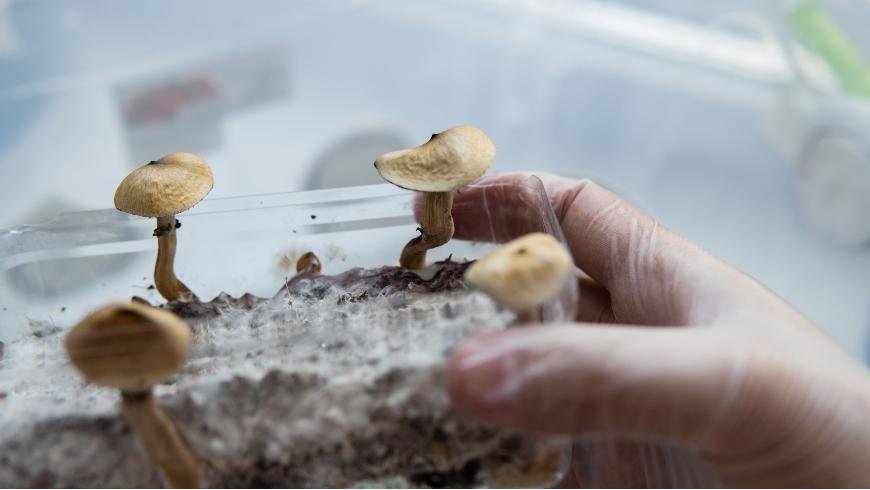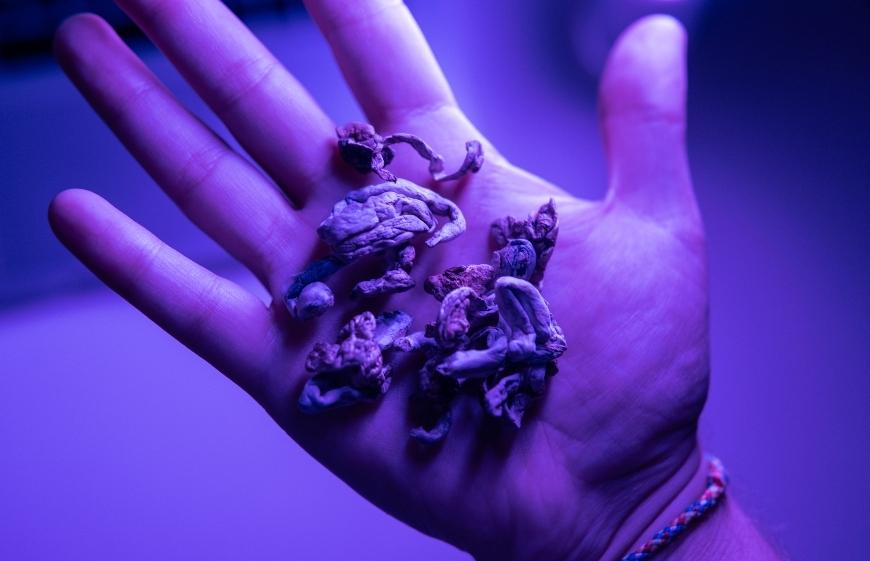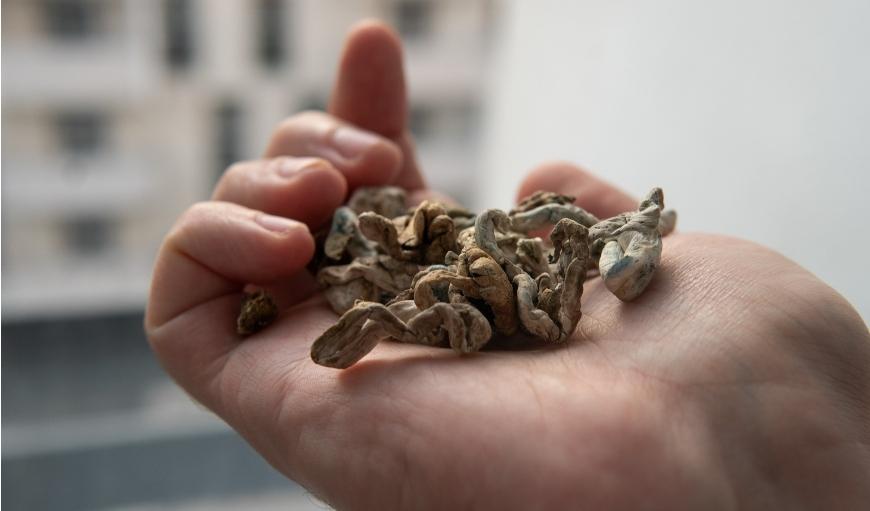How to Prevent Mold on Magic Mushrooms
Discover How to Prevent Mold on Magic Mushrooms with our essential tips, ensuring fresh and safe psilocybin mushrooms for your psychedelic experiences.

How to Prevent Mold on Magic Mushrooms is an essential skill for any enthusiast looking to grow and enjoy these psychedelic wonders. In this blog post, we'll explore the methods of preventing mold growth on magic mushrooms so that enthusiasts can enjoy their psychedelic wonders safely.
Mold contamination is a common issue that can ruin entire batches of magic mushrooms, rendering them unsafe for consumption. By understanding how to identify mold on your precious fungi and implementing preventative measures, you'll be able to protect your harvest and continue enjoying the unique experiences offered by these powerful psychedelic drugs.
In the following sections, we will explore best practices in addressing mold contamination, wearing personal protective equipment while handling mushrooms, assessing cultivation methods for optimal growth conditions, ventilation considerations within growing environments, and safeguarding your magic mushrooms from potential threats. So buckle up as we embark on this informative journey towards preventing mold on magic mushrooms!
Table of Contents:
- Identifying Mold on Magic Mushrooms
- Preventing Mold Growth
- Dealing with Mold in Magic Mushroom Cultivation
- Protecting Your Magic Mushrooms with Personal Protective Equipment
- Assessing Cultivation Methods
- Ventilation is Key for Mold-Free Magic Mushrooms
- Safeguarding Your Magic Mushrooms
- Conclusion
Identifying Mold on Magic Mushrooms
Mold is a common issue for magic mushroom cultivators. It's crucial to identify and address mold growth early to prevent potential health risks. Molds found on fresh mushrooms (and dried mushrooms) can be harmful if ingested, causing allergic reactions or respiratory issues. Some of the most common molds that affect mushrooms are green mold (Trichoderma), cobweb mold (Cladosporium), and black pin mold (Aspergillus).

Types of Mold
Green mold is characterized by its bright green color and fuzzy appearance. It usually starts as small spots on the substrate before spreading rapidly. Cobweb mold resembles spider webs with thin white filaments covering the surface of your growing medium or even your mushrooms themselves. Lastly, black pin mold appears as tiny black dots that can grow into larger patches.
Signs of Mold
- Discoloration: Look for any changes in color on your substrate or fruiting bodies.
- Unusual odors: If you notice an unpleasant smell emanating from your growing environment, investigate further.
- Slimy texture: Mold can cause a slimy film to form on your psilocybin mushrooms.
Potential Health Effects
Mold on magic mushrooms can cause allergic reactions or respiratory problems if ingested. It's essential to remove affected areas immediately and clean your cultivation area thoroughly.
Identifying Mold vs. Mycelium
Healthy mycelium growth can sometimes resemble mold. For example, healthy mycelium can appear as a white fluffy substance similar to cobweb mold. To differentiate between the two, you can lightly mist the suspected area with water. If it shrinks or disappears after misting, it is likely cobweb mold rather than healthy mycelium.
Remember to closely monitor any changes in color or smell within your growing environment. If any irregularities are observed, further examination should be conducted and preventive measures taken to safeguard wellbeing.
Preventing Mold Growth
Mold growth on magic mushrooms can be a real bummer, but fear not. With proper care and attention to detail, you can prevent mold from taking over your precious fungi. The key is maintaining a clean and sterile environment throughout the cultivation process.
Sterilization Techniques
Ensuring proper sterilization of materials and equipment prior to use is critical in preventing mold growth. This includes using pressure cookers or steam sterilizers for substrates and jars, as well as wiping down surfaces with alcohol or bleach solutions.
Humidity and Temperature Control
Magic mushrooms thrive in specific humidity levels (around 95%) and temperatures (between 75-80°F). Maintaining these conditions will help prevent mold spores from finding a suitable environment to grow. Invest in a quality hygrometer to monitor humidity levels accurately, while also using heaters or fans when necessary to regulate temperature.
- TIP: Avoid excessive moisture by misting only when needed - overwatering creates an ideal breeding ground for molds.
Clean Materials & Equipment
It's crucial always to use fresh substrate material like pasteurized straw or vermiculite instead of reusing old ones that may harbor contaminants. Also, make sure any tools used during cultivation are cleaned thoroughly between uses.
In addition to these preventative measures, it's essential always to keep an eye out for signs of mold contamination during each stage of mushroom growth - early detection allows you more time to address issues before they become severe problems. Wear PPE, ensure good air flow, and you'll be well on your way to a bountiful crop of mushrooms free from mold. Stay vigilant, stay clean, and enjoy a successful harvest.
Dealing with Mold in Magic Mushroom Cultivation
Mold contamination is a serious issue for magic mushroom growers. Mold can have a detrimental effect on both the quality and safety of your mushrooms, as well as posing potential health risks. If you suspect mold in your cultivation area, act quickly and effectively to minimize its impact.
Removing Affected Mushrooms and Substrate
As soon as you notice any signs of mold on your mushrooms or substrate, remove them immediately. Dispose of affected materials properly by sealing them in plastic bags before throwing them away. This helps prevent the spread of mold spores to other areas.
Cleaning and Disinfecting Your Cultivation Area
After removing contaminated items, thoroughly clean all surfaces within the growing space using a mold-killing solution, such as bleach diluted with water (1:10 ratio). Be sure to wear gloves during this process to protect yourself from direct contact with mold spores. Additionally, make sure that all equipment used for cleaning is either disposable or sanitized afterward.
Air Purification
Consider investing in an air purifier with a HEPA filter to trap airborne particles, such as mold spores, for enhanced cleanliness and sterility within the grow room. These devices can help maintain cleaner air within your grow room environment.
Maintaining Sterile Conditions
Always practice good hygiene when handling magic mushrooms and their substrates - wash hands frequently, use sterilized tools, avoid touching surfaces unnecessarily, and keep pets out if possible since they may carry contaminants into space inadvertently.
Monitoring for Recurrence
After addressing mold contamination, continue to monitor your grow area closely for any signs of recurrence. Regularly inspect mushrooms and substrates for visible mold growth or other indicators like musty odors. If you notice any issues, take immediate action to prevent further spread.
In summary, addressing mold contamination in magic mushroom cultivation requires prompt removal of affected materials, thorough cleaning and disinfection of the growing space, maintaining sterile conditions during handling procedures, and ongoing monitoring for potential recurrence.
Protecting Your Magic Mushrooms with Personal Protective Equipment
Maintaining a sanitary atmosphere is essential for the growth of magic mushrooms, and using PPE (Personal Protective Equipment) helps to ward off the transmission of mold spores. PPE includes gloves, masks, and disposable coveralls that protect both you and your mushrooms from contamination.
The Centers for Disease Control and Prevention (CDC) recommends using PPE to minimize exposure to harmful substances like mold spores. Gloves prevent direct contact with contaminants on surfaces or substrates while handling mushrooms. Masks filter out airborne particles, including mold spores that could contaminate your grow area or cause respiratory issues if inhaled.
Gloves, Masks, and Coveralls
- Gloves: Use disposable nitrile or latex gloves when working with your mushroom setup. Replace them frequently to avoid cross-contamination between different tasks.
- Masks: Wear a mask rated N95 or higher to effectively filter out small particles like mold spores during cultivation activities.
- Coveralls: Disposable coveralls can provide an additional layer of protection by covering clothing that may have come into contact with contaminants outside the grow area.
Good hygiene habits are also essential before entering the grow space. Washing hands thoroughly with soap and water helps remove potential contaminants from skin surfaces before donning gloves. Additionally, keep separate footwear designated specifically for use within the growing area to prevent tracking unwanted dirt or debris into the space where mushrooms are cultivated.
By incorporating these safety measures, you can minimize the risk of mold contamination and ensure a successful harvest. Protect yourself and your magic mushrooms with proper PPE and hygiene practices.
Assessing Cultivation Methods
Growing magic mushrooms requires expertise and attention to detail. To prevent mold issues, assess your cultivation methods and make necessary adjustments. Create an environment that discourages mold growth while promoting healthy mushroom development.
Evaluating Substrate Choices
The choice of substrate plays a crucial role in preventing mold contamination. Some substrates are more resistant to molds than others. Coir-based substrates are less susceptible to contamination compared with options like straw or manure. Research the best substrate for your specific strain of magic mushrooms and consider switching if you've had recurring mold problems.
Maintaining Proper Sterilization Techniques
Ensure all equipment is clean before use to minimize the risk of introducing contaminants into your grow area. Be diligent about sterilizing jars, gloves, syringes, and any other tools used during the cultivation process. Consider using a pressure cooker or autoclave for thorough sterilization.
- Cleanliness Is Key: To reduce the risk of contamination from external sources, maintain good hygiene practices within your growing space by regularly cleaning floors and surfaces with disinfectants like bleach solution or hydrogen peroxide.
- Pasteurize Your Substrates: Pasteurizing substrates before inoculation can help kill off unwanted microorganisms without damaging beneficial ones needed for successful mycelium colonization.
Optimizing Environmental Conditions
Magic mushrooms thrive in specific temperature and humidity ranges, which can vary depending on the strain. By maintaining these optimal conditions, you create an environment less conducive to mold growth. Invest in a quality hygrometer and thermometer to monitor your grow area's climate accurately.
Experimenting with Different Techniques
Various cultivation methods are available for growing magic mushrooms, such as the PF Tek method, monotub technique, or using pre-made grow kits. If you've experienced mold issues with one approach, consider trying another that may be better suited to your needs and environmental factors.
Assessing and adjusting your cultivation methods is essential for preventing mold contamination in magic mushroom grows. Studying and being mindful of the details can aid in sustaining a clean atmosphere, which will help mushroom growth while reducing the chances of hazardous molds.

Ventilation is Key for Mold-Free Magic Mushrooms
Don't let mold ruin your magic mushroom cultivation dreams. Proper ventilation is crucial for keeping your mushrooms healthy and free from contamination. Here are some important factors to consider:
Air Exchange
Mushrooms need fresh air to thrive. Use a fan or automated system to maintain consistent airflow without blowing directly on your precious fungi.
Humidity Control
Humidity is important for mushroom growth, but too much can lead to mold. Use a hygrometer to monitor levels and employ dehumidifiers or humidifiers as needed to maintain optimal conditions.
Substrate Choice & Preparation
Choose substrates like coco coir or vermiculite that retain water well while allowing oxygen exchange. Properly pasteurize or sterilize your substrate to eliminate any existing mold spores.
Cleanliness & Organization
A clean and organized growing area is essential for minimizing mold risks. Regularly sanitize surfaces, tools, and equipment with a 10% bleach solution. Keep clutter to a minimum to facilitate airflow and spot potential mold issues early on.
By considering these ventilation factors, you'll be on your way to a successful and mold-free magic mushroom harvest.
Safeguarding Your Magic Mushrooms
Keeping your magic mushrooms safe and healthy during cultivation is crucial for a successful harvest. Here are some essential tips to ensure a clean and sterile growing environment:
Maintain a Clean Growing Space
Regularly clean and sanitize your growing area to prevent mold spores from taking hold. Use a diluted bleach solution to wipe down surfaces, invest in an air purifier, and use HEPA air filters to keep airborne contaminants at bay.
Choose Quality Substrates and Spores
Reduce the risk of contamination by selecting high-quality substrates and spore syringes from reputable suppliers. Sterilize substrates before inoculation using methods like pasteurization or pressure cooking.
Avoid Overwatering Your Mushrooms
While fresh mushrooms require moisture, too much water can create an ideal environment for mold growth. Monitor humidity levels closely, aiming for around 90% relative humidity during colonization and 85% during fruiting stages.
Create Proper Air Exchange Systems
Poor ventilation can lead to stagnant air, promoting mold growth on magic mushrooms. Ensure proper fresh air exchange by implementing passive airflow systems like holes covered with micropore tape or active systems like fans on timers.
Incorporate Good Hygiene Practices
Minimize contamination risks by washing your hands thoroughly and wearing gloves when handling mushrooms or equipment. Consider wearing a mask to prevent the spread of mold spores from your breath.
By following these guidelines and maintaining cleanliness, you can significantly reduce the risk of mold growth and enjoy healthy, potent harvests. Remember, prevention is always better than cure, so invest time in maintaining a clean and sterile environment for your magic mushrooms.
Conclusion
Now you know how to prevent mold on magic mushrooms. Identifying mold on magic mushrooms can be a daunting task, but with these tips, you can prevent its growth and keep your harvest safe for consumption.
- Proper ventilation is key to preventing mold growth, so make sure your cultivation area is well-ventilated.
- Wearing personal protective equipment, such as gloves and a mask, can also help prevent contamination.
- Consider using a different cultivation method, such as a monotub, to reduce the risk of mold growth.
- If you do notice mold on your mushrooms, remove them immediately and dispose of them properly to prevent further contamination.
- Regularly clean and sanitize your cultivation area to prevent the buildup of harmful bacteria and mold spores.
By following these tips and tricks, you can ensure a successful and safe dried mushroom harvest.






































































































































